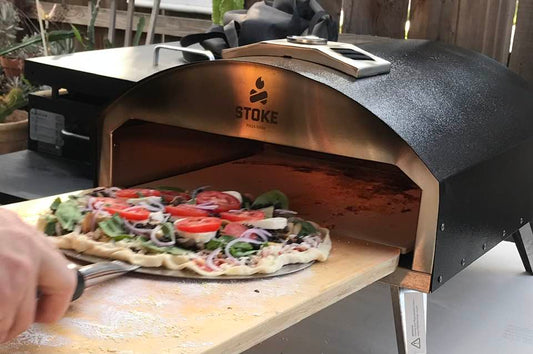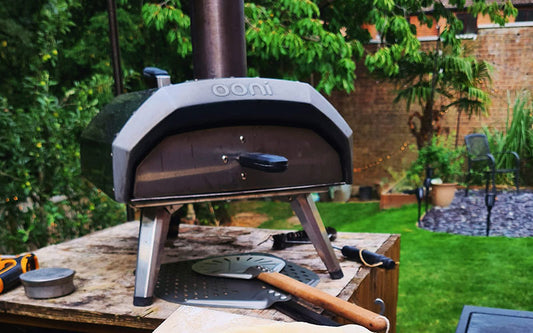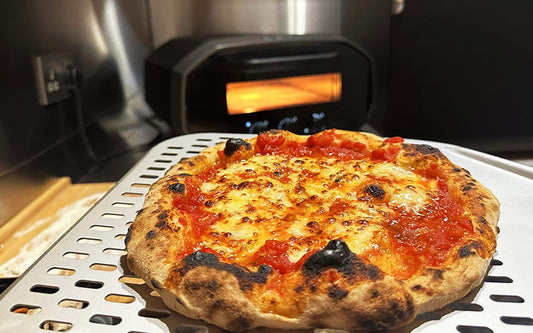Picture this – it’s Friday night, and I’m eagerly waiting for my pizza to come out of the oven. The oven “dings” and I take the perfectly baked pie out of the oven. But as soon as I start slicing, I realize that my pizza cutter has lost its edge. The toppings are dragging, and the crust is getting squished. I’m left with a sad excuse for a pizza…
You see, pizza cutters get dull over time due to frequent use and exposure to moisture. But investing in a pizza cutter sharpener can revive your trusty tool instantaneously. Plus, it’s a one-time investment that will save you from the agony of a dull pizza cutter in the future.
So, if you are a pizza perfectionist like me and you want to improve your pizza game, read this. I’m going to share in this article all you need to know about pizza cutter sharpeners. This includes the various types that are available, step by step instructions for their use.
Unveiling the Mystery: Why Pizza Cutters Lose Their Edge?
Since you’ve taken the pains to read this article, I’m assuming you understand the frustration of a dull pizza cutter all too well. Me too, friend. Me too.
I’ve noticed that no matter how well I take care of them, they always seem to lose their edge over time. But why do pizza cutters get dull? Here are some reasons based on my personal experience:
The Culprit Behind Dullness: Frequent Use
The more you use your pizza cutter, the more wear and tear it experiences. Over time, the blade can become less effective at slicing through the crust and toppings.
Rust and Blunt: How Moisture Affects Sharpness
Moisture accumulation can be a problem if you don’t completely dry your pizza cutter after washing it. When moisture lingers on the blade and handle, it creates an environment conducive to rust and corrosion. As a result, the blade can lose its sharpness and become dull over time.
Cutting on Hard surfaces:
Another factor that can contribute to a dull pizza cutter is cutting on hard surfaces like cutting boards or countertops. The blade is more likely to suffer nicks or chips when it repeatedly encounters these rigid surfaces. Consequently, it can lead to a faster deterioration of the cutting edge.
Poor-quality Materials
Not all pizza cutters are created equal. If you use a pizza cutter made with subpar materials and a cheap blade, chances are it will lose its sharpness over time.
Neglecting the Sharpening: A Key Factor
Failing to sharpen your pizza cutter periodically increases the likelihood of it becoming dull.
Decoding Pizza Cutter Sharpeners: More Than Just Knife Sharpeners
As the name suggests, pizza cutter sharpeners are designed specifically for the job in question. With no additional work, you’ll always have a sharp cutter.
The Mechanics of Pizza Cutter Sharpeners
Pizza cutter sharpeners are usually small, portable devices that can be easily stored in your kitchen. They are designed to accommodate the circular shape of pizza cutter blades, ensuring a proper sharpening angle for optimal results.
These sharpeners work almost like knife sharpeners but are geared more toward the rotating blades of pizza cutters. Using a pizza cutter sharpener is fairly easy.
All you need to do is place the sharpener on a flat surface. Then, pass the pizza cutter through it repeatedly until the blade reaches the desired sharpness.
Benefits of Using a High-quality Pizza Cutter Sharpener:
- Ease of Use: Pizza cutter sharpeners are simple to use and almost impossible to mess up. You just roll the pizza wheel across the sharpener, and that’s it
- Efficiency: These sharpeners are designed specifically for pizza cutters, ensuring that the blade is sharpened evenly and effectively
- Cost-effective: Pizza cutter sharpeners are relatively inexpensive, making them an affordable option for maintaining your pizza cutter’s sharpness.
Alternative Sharpening Methods: 8 Creative Tools for Your Pizza Cutter
While pizza cutter sharpeners are the ideal sharpening tool for pizza cutters due to their design, there are other effective methods to sharpen a pizza cutter.
Mind you that these methods can be more challenging and time-consuming compared to using a dedicated pizza cutter sharpener
1. Mastery with a Whetstone
A Whetstone is by far one of the best tools for sharpening a pizza cutter, in my experience. If you have a whetstone lying around in your kitchen, go ahead and use it to sharpen your pizza cutter.

Whetstones come in different grits and can be used to sharpen both sides of the blade at the same time, ensuring that the blade is sharpened evenly.
I usually soak the whetstone in water for 15 minutes. Then I position it on a flat surface at the desired angle and start sharpening my pizza cutter. When used correctly, a whetstone would sharpen both sides of the blade evenly, and my pizza cutter would be as good as new!
2. The Versatile Puck Sharpener
I have a funny story about using a puck sharpener to sharpen my pizza cutter. I had never heard of a puck sharpener before. But I saw one at a kitchen supply store and thought it looked interesting. I decided to give it a go.
I placed the puck sharpener on a flat surface and ran the blade of the pizza cutter over it in a circular motion, as I had seen in a tutorial online. I was surprised at how easy it was to use and how quickly it got the job done.
However, when I went to cut my next pizza, I realized that I had sharpened the blade too much! The pizza cutter was so sharp that it cut through the pizza like butter. But it also cut through the cardboard box underneath!
Lesson learned: be careful when using a puck sharpener to sharpen your pizza cutter, and don’t overdo it!
One more thing. While using a puck sharpener is easier than using a whetstone, using a whetstone provides better results and is more versatile.
3. Repurposing Your Knife Sharpener
Although the rotating blade makes it challenging, you can use a knife sharpener to sharpen a rocker or half-moon-shaped pizza cutter. During the process, make sure to sharpen both sides of the blade evenly for optimal sharpening.
4. Honing Excellence with a Rod
A honing rod is designed to keep its blade sharp and ready for action. It’s basically a long, slender rod crafted from either steel or ceramic material. Using it is a breeze – all you need to do is glide the blade of your pizza cutter along the rod, maintaining a gentle 20-degree angle.
This simple act works wonders by reestablishing the proper alignment of the blade’s edge, ensuring its sharpness is maintained. Honing rods are user-friendly tools that deliver impressive results, particularly when used on a regular basis.
5. The Convenience of Electric Sharpeners
An electric sharpener typically features an abrasive wheel to sharpen the blade of your pizza cutter. You simply have to insert the blade into the device and turn it on. The sharpener will do the rest. Electric sharpeners are blazing fast and easy to use.
On the downside, they can be quite noisy. That said, if you own a rocker pizza cutter, this would be the ideal tool for sharpening this bad boy.
6. Manual Sharpeners: A Hands-On Approach
A manual sharpener is a handheld device, as opposed to an electric sharpener. It requires you to insert the blade into the device and then run it back and forth motion over a sharpening stone or other abrasive surface.
Manual sharpeners can be quite effective, but they require some skill and practice to use properly.
7. Nail Files: An Unexpected Sharpener
Yes, you can use an abrasive nail file to sharpen a pizza cutter. Cool, right? In fact, it is the easiest way to sharpen the blades of your pizza cutter in a pinch. Use short strokes to run the nail file over the blade’s existing edge.
However, do keep in mind that the effects of using an abrasive nail file may not be as long-lasting as some of the other methods mentioned in the search results.
I personally wouldn’t recommend using an abrasive nail file to sharpen a pizza cutter unless you are out of other options.
8. Belt Grinder: The Industrial Choice
Belt grinders are another excellent option for sharpening pizza cutters. It is a power tool used for grinding, deburring, and finishing metal surfaces.
In order to sharpen a pizza cutter with a belt grinder, turn it on, hold the cutter at an angle to the moving belt, and apply pressure with your finger to control the wheel’s spin.
This will ensure an even grind around the blade. However, belt grinders can be large and expensive. So, if you don’t already have a belt grinder, you can use any of the above-mentioned tools to sharpen your pizza cutter.
Important note: Wear protective gloves when sharpening your pizza cutter for safety purposes. Also, avoid using the pizza cutter on hard surfaces if possible to maintain its sharpness.
Selecting the Ideal Sharpener: A Guide for Every Pizza Cutter
Choosing the right pizza cutter sharpener can be time-consuming and hella confusing, especially if you’re not familiar with the different types of sharpeners available.
As someone who has gone through the grind before, I can tell you that there are several factors to keep in mind when making your decision. Here are some of the things to consider:
Matching Sharpener to Cutter Type
The type of pizza cutter you have will determine the type of sharpener you need. For instance, a rocker pizza cutter will require a power tool or a knife sharpener for best results.
On the other hand, traditional wheel pizza cutters can be sharpened with a whetstone, puck sharpener, or honing rod. Dedicated pizza sharpener tools can do the job for both types of cutters.
Understanding Grit Levels for Optimal Sharpness
If you’re using a whetstone or diamond-sharpening stone, the grit level is an important factor to consider. A higher grit level will produce a finer edge, while a lower grit level will produce a coarser edge. I’d say a whetstone with a grit level of 1000-3000 is ideal for sharpening a pizza cutter.
Edge Grip
An edge grip is a feature that is commonly found on knife sharpeners and certain types of pizza cutter sharpeners. The edge grip mechanism holds the blade at a specific angle while it is being sharpened. This ensures that the blade gets sharpened evenly and at the correct angle.
This feature is important because sharpening a blade at the wrong angle can damage the blade and make it less effective.
DIY Pizza Cutter Sharpening: A Step-by-Step Guide
Sharpening your pizza cutter at home is easier than you think! Here’s a step-by-step guide to help you sharpen your pizza cutter without slicing your fingers:

1. Gather Your Materials
At first, you will need a sharpening tool such as a whetstone, puck sharpener, or diamond-sharpening stone. You will also need a clean cloth or towel to wipe the blade and a cutting board to test the sharpness.
2. Prepare the Cutter
Before sharpening the blade, make sure the pizza cutter is clean and dry. Remove any food particles or debris from the blade using a damp cloth or paper towel.
3. Sharpen the Blade
Depending on the type of sharpening tool you have, follow the instructions provided to sharpen the blade. The precise method will depend on the type of cutter and sharpener you’re using.
4. Test the Sharpness
Once you have sharpened the blade, test the sharpness by cutting a piece of paper or a tomato. If the blade cuts through the paper or tomato easily, then it is sharp enough. If not, simply repeat the sharpening process.
5. Clean and Dry the Cutter
After sharpening the blade, wipe it clean with a cloth or paper towel. Make sure the blade is completely dry before storing the pizza cutter.
Remember to sharpen your pizza cutter regularly to keep it in top condition.
The Bottom End
Now that you know all about pizza cutter sharpeners, you can say goodbye to struggling with a dull pizza cutter for good! No matter which sharpening tool you choose, the key is to keep your pizza cutter sharp and in top condition.
Remember to choose the right type of sharpener for your specific pizza cutter. And more importantly, use it carefully to avoid damaging the blade.




